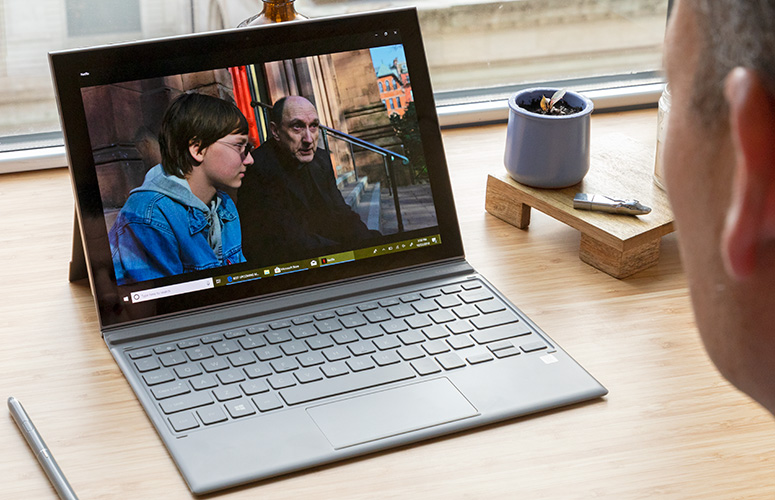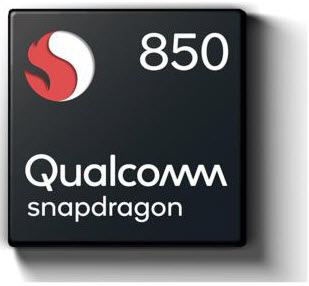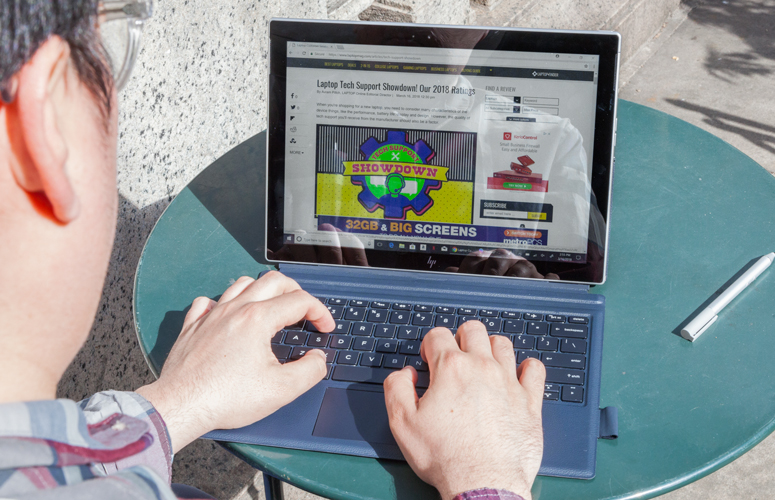$999 for a Netbook? Snapdragon-Powered PCs are a Rip-Off
It's a great idea, on paper anyway: you give Intel and AMD some healthy competition by building a series of Windows 10-powered 2-in-1s that use Arm processors like the Qualcomm Snapdragon 835 and 850. Qualcomm's processors are much more power-efficient than their x86 competitors and they're really good at doing things like running background programs while asleep or connecting to LTE via their built-in 4G modems. Unfortunately, thus far, they aren't great at running Windows programs, but manufacturers don't seem to have gotten the memo.
Companies such as Samsung, Lenovo and HP are charging as much as a thousand dollars for these devices, which they call "Always-Connected PCs." That's an exorbitant amount for what's essentially a latter-day netbook, an underpowered but very-portable computer that, at best, is only powerful enough to serve as a secondary device for someone who already has a capable PC waiting at home.
I just reviewed the Samsung Galaxy Book 2, the first 2-in-1 to ship with Qualcomm's new Snapdragon 850 CPU, a processor that is purpose-made to run Windows 10 on Arm. At first glance, this detachable looks like it's worth every penny of its premium price ($999 in the U.S. , TBD in the UK). You get a gorgeous 12-inch OLED display that makes colors liker the blue in an ocean come to life. There's an attractive metal chassis, great sound output, a pair of sharp cameras, a bundled keyboard with really good tactile response and a decent stylus in the box.
Performance Issues
But the Book 2's beauty is only skin deep. During my tests, its Snapdragon 850 chip struggled with Chrome, the world's most popular web browser while its paltry 4GB of RAM made multitasking painful. When I surfed the web with over a dozen tabs open and a YouTube video streaming in another window, there was significant lag. Every time I changed tabs, I had to wait a couple of seconds for the page to redraw, even though the pages were finished loading. At times, the system locked up for a few seconds.
To see how a similarly-priced, Intel-powered computer would handle the same workload, I tried opening over a dozen tabs and playing video on a Surface Pro 6 with a Core i5 CPU and 8GB of RAM. Not only was there no perceptible lag when changing tabs, but web pages loaded a lot faster, even though both the Surface and the Galaxy Book 2 were on the same Wi-Fi network.
One major performance challenge is that Snapdragon chips have to run standard win32 apps like Chrome in x86 emulation mode. If you download an app from the Microsoft Store, it will be compiled for ARM processors already and run more smoothly. So Edge, Microsoft’s own browser, ran better than Chrome, but it still had plenty of lag when switching tabs.
Incompatible Apps
Snapdragon chips can only run 32-bit win32 apps, so you can rule out any program that, like Adobe Photoshop Elements or Creative Cloud, is only available in 64-bit versions. And, even among 32-bit apps, any that require special drivers won't work. So, OpenVPN, a very popular VPN client that I need for work, won't run on an Always Connected PC because it needs to install its own TAP driver in order to work and the driver isn't compatible with Arm.
Get Tom's Hardware's best news and in-depth reviews, straight to your inbox.
Microsoft and Qualcomm know that Snapdragon's x86 emulation isn't great, so they preload these devices with Windows 10 in S mode, which only allows you to install apps from the Microsoft Store but can be disabled in a couple of clicks. So, if you're happy with Edge, Microsoft Office and the scaled-back image editing, coding and other software you find there, you can have a palatable, though unimpressive user experience. That is,provided you don't load many programs at once and you don't store too much data.
Low-end Specs, High-end Pricing
Keep in mind that most of the Snapdragon computers, including the Galaxy Book 2 and the older HP Envy x2 and Lenovo Miix 630, you get just 4GB of RAM and 128GB of storage at the most. In 2018, no computer that costs more than $500 should have less than 8GB of RAM, but all of these systems are priced at $799 or higher.
Some may argue that Always-Connected PCs are good enough to be primary PCs for less-demanding users, but that explanation just doesn't mesh with reality. Someone like my septuagenarian mother, who knows how to use PCs but doesn't understand how they work, has even less tolerance for lag and unresponsiveness than a tech enthusiast like me. When I click on something and the system pauses for a few seconds, I will sit there and wait because I know the system is overwhelmed. But my mother will get frazzled and start clicking over and over again, because she expects the system to "just work."
Second Coming of the Netbook
As netbooks like the Asus Eee PC showed all the way back in 2008, there's a place in the market for light-weight, long-lasting companion devices. If you have a powerful desktop at home but need a computing device to use for note-taking in class or writing work emails on the train, you can benefit from secondary computer like an Always-Connected PC. However, that benefit isn't worth anywhere close to $799.
Cheaper or Better Alternatives
At the height of the netbook craze in 2008 to 2010, new 10 or 11-inch laptops with Atom processors usually cost $500 to $650 (£390 - £500). At that time, ultraportable laptops like the MacBook Air cost at least $1,000 more than that. Today, you can get a superior primary device for around the same price or, at most, $129 / £104 more than the Galaxy Book 2. The Surface Pro 6 costs $1,029 / £1,004 with keyboard or $1,129 / £1,104 with pen.
If you don't require a detachable and just want a powerful lightweight laptop, you can get a bendback 2-in-1 like the Lenovo Yoga 730 or a traditional clamshell like the Asus ZenBook 13 for less than $800 / £899.99.
When you just want a secondary device, the true use-case for these Snapdragon laptops, you can get a good one for less than $600 / £600. Microsoft's detachable, 10-inch Surface Go starts $399 / £379 or $599 / £599 with keyboard and pen. Even that's a lot of coin. If you can live with a bendback Windows machine, you can find one for less than $350 / £350 in the Acer Spin 1 or Dell Inspiron 11 3000 2-in-1.
And finally, if you just need to surf the web and send some emails, the best low-cost choice is a cheap Chromebook, which you can get for less than $300 / £300 and sometimes less than $200 / £200. And, unlike the Always-Connected PCs that cost 3 to 5 times as much, it will run Chrome browser without a hitch.
Outlook
None of the suggested alternative above come with 4G LTE modems, though the Surface Go is supposed to be getting a cellular option eventually. No doubt on-board 4G is a huge convenience, but there are simple alternatives like using the hotspot feature on your phone, that make it more of a nice-to-have than a necessity.
I really hope Arm-powered Windows computers become serious competitors for their Intel and AMD-based brethren, but to get there, they will need to either offer equivalent performance or humble, budget-friendly pricing. But no matter how great their screens or chassis, today's Always-Connected PCs just aren't worth the money.
Note: As with all of our op-eds, the opinions expressed here belong to the writer alone and not Tom's Hardware as a team.
Avram Piltch is Managing Editor: Special Projects. When he's not playing with the latest gadgets at work or putting on VR helmets at trade shows, you'll find him rooting his phone, taking apart his PC, or coding plugins. With his technical knowledge and passion for testing, Avram developed many real-world benchmarks, including our laptop battery test.
-
mlee 2500 NOBODY should be selling a Windows 10 PC of ANY sort with only 4GB of memory in this day and age.Reply
I'm very disappointed in Qualcomm or the OEM/VAR's...whichever was responsible for this decision. If you KNOW you already don't have any wiggle room performance wise then WHY would you make this particular mistake.
Unconscionable and unforgivable error, even for an Intel or AMD based laptop. -
hannibal Yes some laptops Are rippoff... better compare these with Intel atom Powered 14” 4K screen laptops that have 4G modem... then there would be Computer that really would be somewhat same as these... there just Are not so high end atom computers that would compete with these. Instead we have Intel i5 or i7 based ultrabooks that cost 1700-2500$... hmm... not comparable with those neither.Reply
Snapdragon based ultrabooks Are very spesific things to very spesific task. Not for normal Mr Jones. -
Brian_R170 I still don't understand why x86 laptops with LTE modems are so expensive. LTE modem chips cost around $10, but even the lowest-end x86 laptops with them cost over $800, and the vast majority are well over $2000.Reply -
travis.scott85 I read stuff like this and I feel Tom's Hardware should stick to hardware testing. These are not "netbooks". They can run full windows 10 pro, they can join domains, remote access, and through emulation can support MOST desktop apps that business users need, on top of that, it is an always connected device. There's a distinction between that and an intel device with LTE. Even in hibernate or standy, short of you turning it OFF it still receives your messages, emails, notifications. This is ESSENTIAL in the business world, and the main reason why people are more reliant in smart phones, because that information is there instantly, no boot up. I can have Teams, Outlook, messaging and SMS texts going on, while my laptop is closed and I'm moving somewhere and open it to take a glance. Now for the 999 price point. Where's the Tom's Hardware piece lambasting Apple.. or Samsung.. about how expensive their flagship phones are. You can pay 200 dollars for phones that do the same thing right? So why the fake outrage over this? These are premium devices that do many if not all the things smartphone can... but are also computers.. so in that regard, 999 is a great dealReply -
jpe1701 I can see the benefit of these to people who need to constantly monitor information for work because of the battery life. I think they are testing the waters to see what people are willing to pay. High end phones with the snapdragon 845 are expensive too and they don't have windows. But yeah, way more than I would pay for the performance.Reply -
alextheblue I agree with the premise of the article. They are overpriced, and they need more RAM. However...Reply
One major performance challenge is that Snapdragon chips have to run standard win32 apps like Chrome in x86 emulation mode.
Not necessarily. Win32 apps (both Store apps and outside programs) can be compiled for ARM, so they run natively. There's a strong rumor that the Windows version of Chrome will be gaining an ARM compile due to Qualcomm's urging.
Edge, Microsoft’s own browser, ran better than Chrome, but it still had plenty of lag when switching tabs.
That's probably due to the lack of RAM more than any other factor.
Snapdragon chips can only run 32-bit win32 apps
Current SD chips. That's one of the things that needs to be corrected going forward, hopefully with the 1000 series. -
beayn "Second coming of the Netbook"Reply
Uh, did we not learn anything from the first wave? They're trash. Waste of money.



